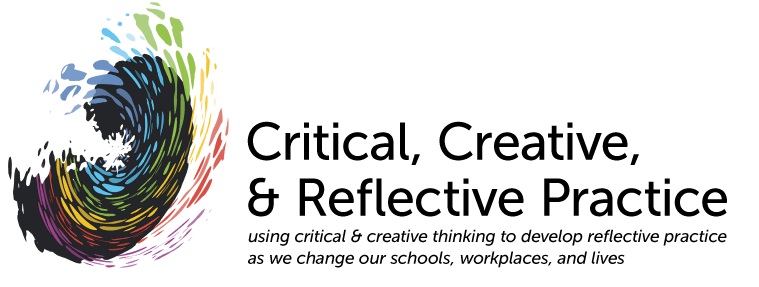Design for Living Complexities
A Collaborative Exploration (CE) that explores how to bring critical thinking into the heart of design practice
Friday August 16, 9.30-5.30, Location TBA
- Preparation: 1) Read Taylor, P. (2001) "Critical thinking as a journey," http://www.faculty.umb.edu/pjt/journey.html and come prepared to relate how the paper intersects with or stimulates your own thinking, especially about the case for the CE; 2) Bring laptop or table if you have one; 3) Be ready to start at 9.30am sharp.
- This text can be viewed at http://bit.ly/CEUOW13.
Led by
Peter Taylor, Director, Graduate Program in
Critical and Creative Thinking, and
Science in a Changing World track, University of Massachusetts, Boston,
peter.taylor@umb.edu
In brief, CEs are an extension of Project-Based Learning (
PBL) and related approaches to education that begin from a real-world scenario or case in which the problems are not well defined, which leads participants to shape their own directions of inquiry and develop their skills as investigators and teachers (in the broadest sense of the word). The basic mode of a CE centers on interactions in small groups (online or face-to-face) over a delimited period of time in ways that create an experience of re-engagement with oneself as an avid learner and inquirer. (
more detail on CEs)
Scenario
The 30+ year-old Critical & Creative Thinking Masters program at UMass Boston has always been about reflective
practice and not purely about
thinking. Recently it was suggested that the program could be renamed Critical, Creative and Reflective Design and some instructors started to flesh out what it would mean to bring design into critical thinking and critical thinking into design, albeit not tied to a specific field (e.g., graphics, architecture, furniture,..). One way to see critical thinking is that we understand ideas and practices better when we examine them in relation to alternatives. In that spirit, a critical thinking design theme is that
byproducts are products. Such a theme would lead us to contrast the conventional idea of that a car engine can be designed with the challenge of designing transportation systems that minimize the health and environmental impacts of CO2 and pollutants from engine exhaust.
In this CE you are invited to help in the fleshing out process. Drawing on what is already happening in design practice, develop modules or units or themes that a) interest you personally and b) bring critical thinking into the heart of design practice. The intended outcomes include: i) tangible products--work-in-progress presentations in the early afternoon that reflect the initial & necessarily rapid inquiries, which are then revised in response to feedback and perhaps ready to share outside the group at the end of the day, ii) experiences that motivate you to continue to pursue self-directed inquiry on this and other topics, and iii) stock-taking that helps improve and develop the CE format. Using this format for a day-long workshop means, in brief, that there is an activity together as a group for an hour four times over the course of the day. In between, time is spent in independent research related to the scenario, in conversations, and as participants choose for themselves.
Timetable (subject to adjustment)
Each session will begin with everyone in one room. After the session is introduced/explained, half the group might move to the other room.
9.30 Overview
9.45-10.45 Session 1, Autobiographical intros
10.45-11.45 Initial inquiries
11.45-12.45 Session 2, Focus on Detailed Case Study (precirculated)
12.45-2.30 Lunch in the room, More inquiry, and preparation of Work-in-progress presentations
2.30-3.30 Session 3, Work-in-progress presentations
3.30-4.30 Revision of presentations for public viewing
4.30-5.30 Session 4, Reflect on experience, outcomes, process, next steps
Session 1; Autobiographical intros
- Preceded by Freewriting to clarify our thoughts about what we hope for from this workshop.
- Gives participants an opportunity to
- 1. introduce ourselves in narrative depth, their current and emerging work in relation to the case,
- 2. learn more about each other
- 3. provide diverse material for cross-connections
- * each person takes 5-7 minutes to tell the story of how we came to be a person who would be interested to participate in a CE on the scenario.
- * each person notes one point from each story that intersects with our own background and one suggestion for extending the work and thinking described (using slips of paper)
- * gather and share our thoughts at the end (using a format like http://bit.ly/CIQ1e). Collated responses
Between-session work: Initial thoughts and investigations of the case & posts (using
files/page/messages/CEUOW13 [ask for login info])
Session 2: Focus on Detailed Case Study (read in advance)
- Taylor, P. (2001) "Critical thinking as a journey," http://www.faculty.umb.edu/pjt/journey.html
- Brief intro by author, then participants take 5 minutes to relate how the paper intersects with or stimulates our own thinking, especially about the case for the CE (while author stays quiet, listening). Author responds at end -> gather and share our thoughts -> closing: taking away to chew on.
Between-session work: More inquiry and posting related to the case. Prepare a
work-in-progress (W-I-P) presentation
- Feel free to prepare a visual aid (on paper or electronically), but keep it simple given the limited time.
Session 3: Work-in-progress presentations
- * 5-7 minutes total for each participant
- * Plus-delta feedback is made by everyone on each presentation (on paper)
- + (=something you appreciated)
- delta (= to be developed further)
Peter Taylor, syllabus:
files/design & "form follows function??":
http://ptaylor.wikispaces.umb.edu/CEUOW13
Between-session work: more inquiry, revise W-I-P presentation into product (shareable to wider world [by a link to a google doc?]?), post reflections (using
files/page/messages/CEUOW13 [ask for login info]).
Session 4: Five-phase format discussion, to reflect on experience, outcomes, process, next steps. End with Closing Circle:
- + (=something you appreciated)
- delta (= to be developed further)
After session 4 (optional): Participants share products to a wider community (by uploading and linking a file below that can be understood without your narration).
